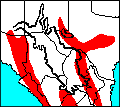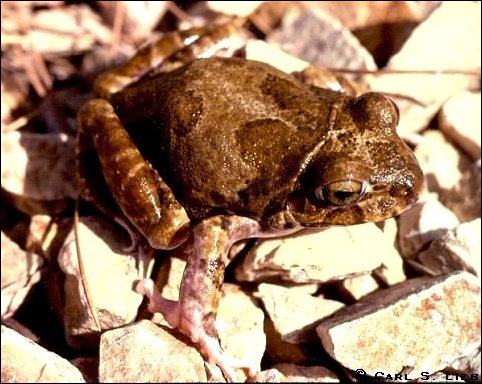


Other common names for this species include Robber Frog, Cliff Frog, and Rock Frog (Wright and Wright, 1949), plus Rana de Bolsa (Liner, 1994). Other scientific names found in zoological literature include Hylodes augusti (before 1920), Eleutherodactylus latrans (used about 1920-1955), Hylactophryne augusti (in use from ca. 1970-1987) and, more recently, Eleutherodactylus agusti. Subspecies occurring in the Chihuahuan Desert Region are Eleutherodactylus augusti latrans (Common name: "Eastern Barking Frog") for Texas and New Mexico populations, and E. a. fuscofemora ("Zweifel's Barking Frog") for populations near Cuatro Cienegas, Coahuila.
Males reach 70 mm in head-body length, females are larger, to 94 mm (Zweifel, 1967). Overall dorsal coloration varies from dark brown to pale gray, with darker circular spots or markings often present. Yellowish suffusions occasionally evident on the back, limbs, and face of large individuals. Ventral surface is uniformly light, with a circular skin fold (ventral disc) extending from the axillary to inguinal region. The forearms are robust, the outer fingers elongate, the tips of the toes somewhat club-like, and the soles and palms are equipped with numerous tubercles. Juveniles are dark gray or gray-green, with have a pronounced light band across the back of the torso.
Widely distributed in central and montane Mexico, Barking Frogs are found in the United States primarily in the Edwards Plateau region and in and near the Pecos River Valley of Texas and southeastern New Mexico. They are also known to occur in the Santa Rita and Pajarito mountains of southeastern Arizona. The Chihuahuan Desert Region distribution includes a population in southern Otero County, New Mexico, scattered populations along the northern Pecos River of Texas and New Mexico, and several populations in northern and central Coahuila (e.g., Cuatro Cienegas region). The species also has an extensive distribution in foothill and montane habitats along the southern margin of the Chihuahuan Desert region of Durango, southern Coahuila, and Nuevo Leóon, and it is probably also widespread in the Saladan Desert province of San Luis Potosái and Zacatecas, just south of the Chihuahuan Desert region proper.
This primarily subtropical and premontane species requires rocky habitats with deep fissures that provide ready access to permanently moist, subterranean microhabitats. Rocky limestone, especially karst, or igneous topography in combination with a high water table is the typical setting; surface vegetation in areas supporting these frogs includes such extremes as Chihuahuan Desert scrub, subtropical deciduous forest, oak-juniper woodlands, and montane pine-oak forest.
Known food items include camel crickets and land snails (McAlister, 1954; Olson, 1959); doubtless other invertebrates are opportunistically taken. Male mating vocalizations carry long distances and sound very much like a barking dog; it is thus possible to hear the frog call in a rural area without realizing the "background noise" is of anuran rather than canine origin. Since these males usually call while hidden deep within crevices of rock outcrops, the sound ventriloquistically bounces off stone faces and makes physical location of the animal particularly challenging (see Wright and Wright, 1949: 372 for a typical field encounter). Several specimens have been collected from caves, but most specimens of barking frogs found in the open were en route to shelter or were females encountered on their way to calling males; seemingly only very humid atmospheric conditions promote such open-air movements.
As in nearly all other frogs, fertilization is external. Unlike most other temperate zone frogs, however, development is direct: eggs are laid in a moist microhabitat underground (e.g., in damp soil under a rock), the larval stage passed inside the egg, and a small terrestrial "froglet" emerges from the egg rather than an aquatic tadpole (Jameson, 1950; Valett and Jameson, 1961). Timing of reproduction varies in different parts of the range. Jameson (1954) felt that breeding in central Texas took place primarily in April and May, but in more arid parts of the range intense calling activity by males seems to be tied to summer rainy periods (e.g., July).
Barking Frogs enjoy no special protective status in Texas or New Mexico, although the restricted distribution in the latter state has made its conservation status a continuing concern of its wildlife management authorities. In Arizona, the species is even more restricted in its distribution and completely protected as a State Endangered form. Nevertheless, like other species of amphibians in the Southwest U.S. and Mexico that are dependent upon moist subterranean habitats maintained by groundwater, barking frogs are potentially threatened by excessive down-draws on the water table and/or contamination of aquifers that inevitably come with increased human utilization of such resources.
The interesting species has the reputation of being rarely encountered over most of its geographic range. Nevertheless, in undeveloped parts of the Edwards Plateau of central Texas, choruses of these frogs can be heard at many locations--if environmental conditions are appropriate and one can recognize the frog's call for what it is. When conditions are less optimal, the species may be relatively abundant in a region but hard to detect. A series of eight specimens from near Cuatro Cienegas, Coahuila, were taken in mousetraps at night; the frogs were otherwise completely unobserved in the area (Schmidt and Owens, 1944).
Degenhardt, W. G., C. W. Painter, and A. H. Price. 1996. Amphibians and reptiles of New Mexico. Univ. New Mexico Press, Abuquerque. xix + 431 pp.
Dixon, J. R. 2000. The amphibians and reptiles of Texas, Second Edition. Texas A&M University Press, College Station. 421 pp.
Jameson, D. L. 1950. The development of Eleutherodactylus latrans. Copeia 1950(1):44-46.
McAlister, W. 1954. Natural history notes on the barking frog. Herpetologica 10(3):197-199.
Olson, R. E. 1959. Notes on some Texas herptiles. Herpetologica 15(1):48.
Schmidt, K. P., and D. W. Owens. 1944. Amphibians and reptiles of northern Coahuila, Mexico. Field Mus. Nat. Hist., Zool. Ser. 29(6):97-115.
Valett, B. B., and D. L. Jameson. 1961. The embryology of Eleutherodactylus augusti latrans. Copeia, 1961(1):103-109.
Wright, A. H. and A. A. Wright. 1949. Handbook of frogs and toads of the United States and Canada. Comstock Publ. Co., Ithaca, New York. xii + 640 pp.
Zweifel, R. G. 1956. A survey of the frogs of the augusti group, genus Eleutherodactylus. American Mus. Novit. (1813):1-35.
Zweifel, R. G. 1967. Eleutherodactylus augusti. Catalogue American Amphib. Rept. 41.1-2.
C.S. Lieb, 6 July 2000.
Last Update: 10 Jul 2009